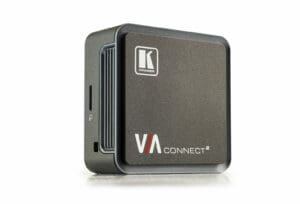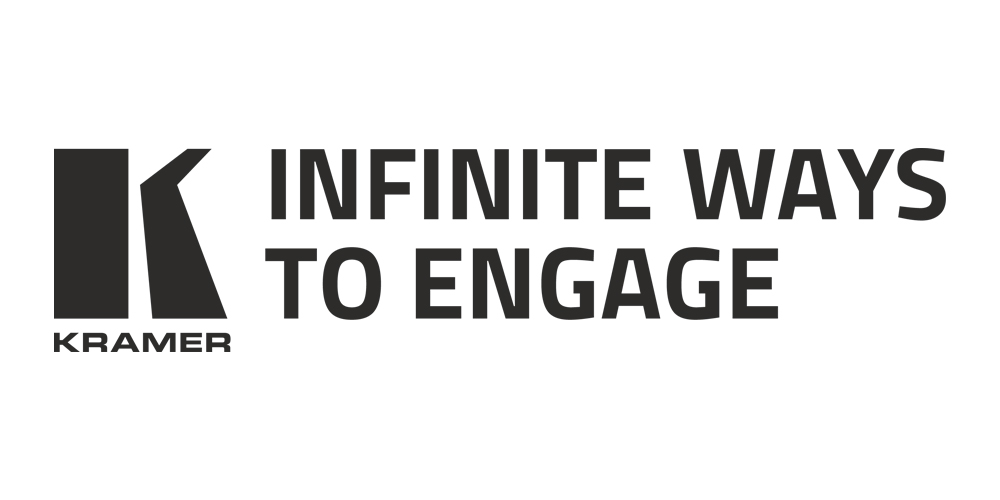Commercial Integrator: You’ve described Kramer as being “a new company.” Help clarify what that means.
Clint Hoffman: The company Kramer was started by Dr. Joseph Kramer back in 1981. This past February, Dr. Kramer retired, and the company was acquired by Fortissimo Capital. That’s one of the largest private-equity companies in Israel. So, we’re now owned by a private-equity company, and that’s a huge change for us. As a natural extension of the acquisition, the company is going through a major transformation. We have a clear goal in mind: We want to become the vendor of choice in the pro AV space. As part of the transformation, new people joined the company, and they have many years of experience in the Israeli high-tech industry.
The company’s management is shaping Kramer’s vision. It’s leading a strong business strategy that consists of innovation and growth, while also leveraging the strong assets that Kramer has built in the last 40 years.
One of the most important changes we already see is the new product and innovation roadmap that has been built for the next few years. That’s based on four megatrends that we identified in the market: always-on collaboration, seamless technology, hybrid world and mission-critical communications. Seeing those trends is what allowed the new management team to build a product roadmap influenced by these things.
 Now, as part of that roadmap, we’re also going to do a couple of things that are really important. First, we’re focusing on an open garden strategy. You want to use our products in the solution as well as somebody else’s? We’re going to be open. We’re not going to be closed, proprietary technology communications. “Open by design,” as a development primary goal, will enable our customers to protect their investment while adding new capabilities to their solutions. Connectivity and integration are essential elements in our industry. And we, of course, design and develop full solutions focused on three main verticals: education, government and military, and enterprise.
Now, as part of that roadmap, we’re also going to do a couple of things that are really important. First, we’re focusing on an open garden strategy. You want to use our products in the solution as well as somebody else’s? We’re going to be open. We’re not going to be closed, proprietary technology communications. “Open by design,” as a development primary goal, will enable our customers to protect their investment while adding new capabilities to their solutions. Connectivity and integration are essential elements in our industry. And we, of course, design and develop full solutions focused on three main verticals: education, government and military, and enterprise.
Second, we’re going to have every single solution we make in the future able to connect to the network and be managed in the cloud. Everything that gets connected to the network will then feed information to the cloud. We look at establishing our data lake that our customers and end users can mine to make important, ROI-based business decisions. And we’re also going to use a common format that’s probably going to be something like USB-C in terms of the interface. Something very standard—not something proprietary. Something that the entire world is very familiar with.
Those fundamentals, combined with the megatrends we’ll talk about, helped shape the new roadmap. This time next year, there’s going to be the start of this transformation of our product offering. Plus, on top of that, we also designated a person to be in charge of strategic partnerships and mergers and acquisitions for the first time. So, there will probably be some non-organic growth in the form of mergers and acquisitions and partnership along the way.
We already completed one. We owned 50% of a company called WOW Vision. So, they had the R&D piece, and we had the sales and marketing piece. Immediately upon Fortissimo’s acquiring Kramer, they acquired the rest of WOW Vision. We have renamed that team Kramer India R&D. And we’ve announced six strategic partnerships at InfoComm—with Logitech, Jabra, Sony, NETGEAR, HSL and Zignage. Strategic partnerships are a big part of our future, as well.
CI: The hybrid world very clearly seems here to stay. What are the implications of that fact?
CH: People are no longer tied to a certain work style or education style. If you look at education, yes, some students are going to be there physically in the room, and that’s important. But other students can participate and have the same inclusive learning experience remotely. And so, that ability to deliver both experiences at the same time is going to be invaluable going forward. We could do that to a certain extent before the pandemic, but all the tools that are necessary to do that have been and are being perfected. They’ve just increased in capability exponentially since the pandemic started.
CI: What will always-on collaboration unlock or enable our industry members to do?
 CH: The fundamental aspect of everything we do is communication. Having that ability to communicate effortlessly and immediately is just going to enable more and more innovation, more and more productivity—all those things. There’s a skit you can watch on YouTube called “A Videoconference Call in Real Life.” It’s people in a conference room, but it’s simulating the online experience where, like, one person’s calling in from the car and, so, they’re breaking up and there’s noise in the background. And then another person’s fading in and out, like with a bad connection. And it’s really about the difficulties that we have had in this style of always-on communication.
CH: The fundamental aspect of everything we do is communication. Having that ability to communicate effortlessly and immediately is just going to enable more and more innovation, more and more productivity—all those things. There’s a skit you can watch on YouTube called “A Videoconference Call in Real Life.” It’s people in a conference room, but it’s simulating the online experience where, like, one person’s calling in from the car and, so, they’re breaking up and there’s noise in the background. And then another person’s fading in and out, like with a bad connection. And it’s really about the difficulties that we have had in this style of always-on communication.
We have to overcome that. We have to get to the point where it just works. Sometimes, when you go to have that Teams meeting in a large-group environment, there are audio problems or incorrect settings. Always-on collaboration means it’s just there and available. There’s no stressing out. That’s what we’re trying to perfect.
CI: Do you think integrators are embracing that zero-fail, always-on mindset?
CH: Well, I think they fully understand that’s what they want to deliver, and they understand that’s what the clients need and the world deserves. But I don’t think we’ve perfected the process and the tools yet. And that’s why it’s a fundamental megatrend for Kramer and the foundation of our product roadmap.
CI: How will society’s desire for seamlessness affect the systems we deploy and the products that our clients use?
CH: There are so many opportunities that it’s hard to boil it down. Here’s one example: I’m here at the office, and I have this little fob around my neck so that I can get in and out of the doors. If I walk into my conference room because we’re going to have a presentation, why can’t that room sense the fob on my neck and recognize that Clint’s here? Basically, “That’s Clint, and this is the meeting he has scheduled. So, let’s put these things on that he’ll need.” That kind of automation…that kind of artificial intelligence…that thing where it just happens is what we’re talking about when we talk about seamless technology.
It’s like when you push the button and the Uber shows up, or you push the button and then there’s a package on your porch from Amazon. It’s just that simple.
CI: Do you think there could be privacy concerns if automation and seamlessness in in-person environments heavily ramp up?
CH: I haven’t given that a tremendous amount of thought, but my immediate reaction, personally, is no. My personal information—like my banking information or my credit score—I’m really worried about protecting. Not so much an office environment that recognizes my face when I walk in a room.
My wife jokes and says, “No matter what I say these days, the next thing I know, it shows up on Facebook.” So, is the phone listening? I guess it is! Because how could you mention some obscure thing and then, 10 minutes later, go to Facebook and see an ad for it? It happens to her all the time. So, that’s the world we live in.
That being said, employee and individual privacy is very important to us, and we understand the limitations necessary to protect privacy. We can easily adapt to them, like many other solutions in the market today.
CI: What are the implications of the commercial AV industry now being mission critical?
CH: Think about applications like telehealth, the hybrid education experience, command and control, and emergency operations centers. As we move to being a safer world…a more effective world…communication in these areas will be critical. It has to be available, and it has to work. If you’re in education and can’t do what you need to do, you’re not making money. If you’re in telehealth—well, health is important, and it had better be working. So, it’s all critical now.
CI: Will the megatrend toward being mission critical help power the shift toward selling services and focusing on RMR?
 CH: I agree with that 100%. We developed the first cloud-based control solution. We call it Kramer Control. But we didn’t develop it to be a control solution. We developed it to be a data-analytics engine that, by the way, is a good control solution. Because you can’t “out-volume-up” the competition. You send a particular command to a particular display and the volume goes up. That’s not complicated.
CH: I agree with that 100%. We developed the first cloud-based control solution. We call it Kramer Control. But we didn’t develop it to be a control solution. We developed it to be a data-analytics engine that, by the way, is a good control solution. Because you can’t “out-volume-up” the competition. You send a particular command to a particular display and the volume goes up. That’s not complicated.
But the fact that we built our solution around the cloud and in the cloud means you don’t have to roll a truck to a site to address whatever you need to address. I could be in a hotel lobby in Aruba on vacation, get a call from a client, go to the lobby computer and log into the account in the cloud. Then, I can check the health and welfare, I can fix something, I can add a new device from wherever I am in the world. And that’s part of being able to respond in a mission-critical fashion.
Frankly speaking, what Chuck [Wilson, from NSCA] is promoting is important because, if I’m an integrator, I’m constantly staying up at night worrying if I have enough projects in my pipeline to make payroll every other Friday. But, if I start developing recurring revenue, and I have an opportunity to provide a solution or service where I’m at the mission-critical beck and call, that’s a certain portion of my revenue each year that I can just write down. And if you have this much recurring revenue, you can calculate that you only need this many projects. So, it is the desire of every owner of every systems integrator. It would be so much to their benefit.










